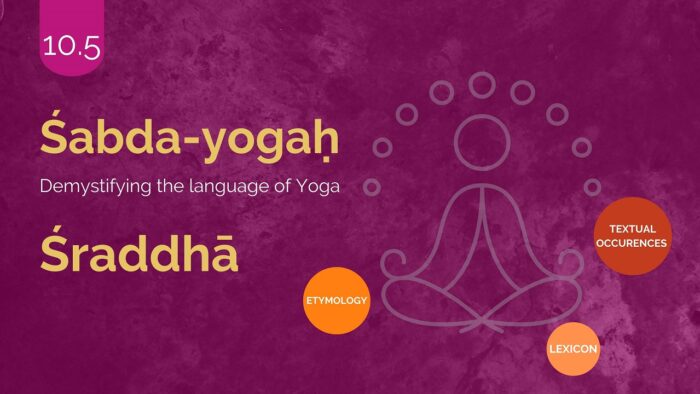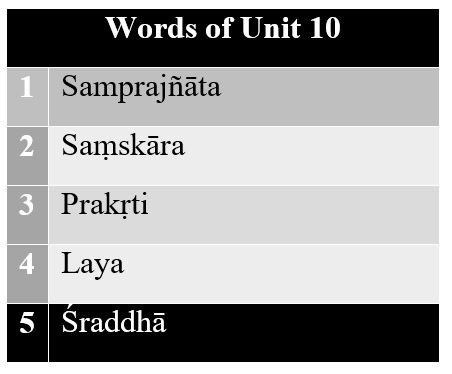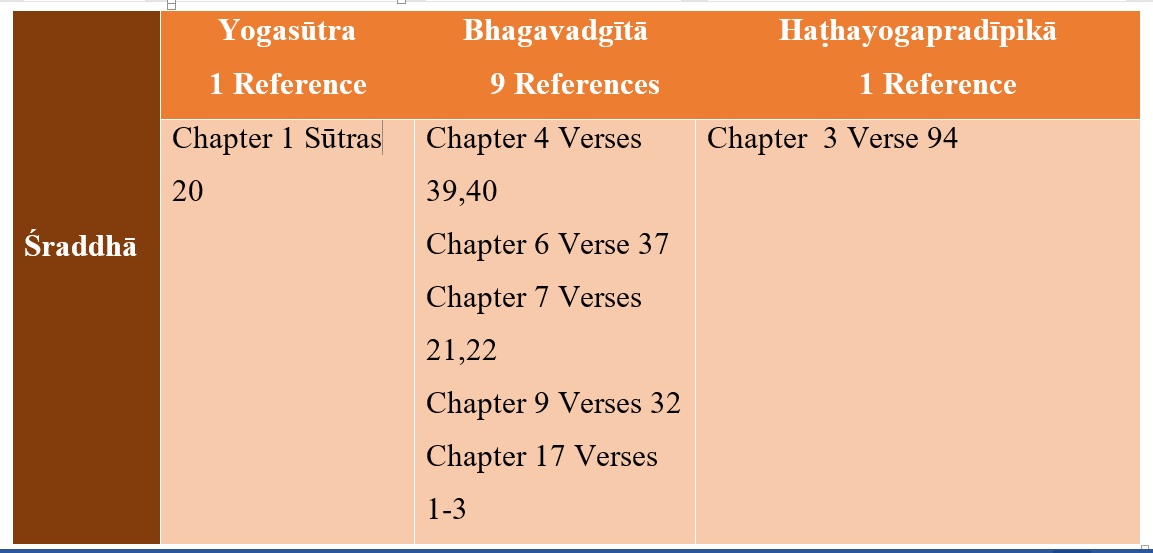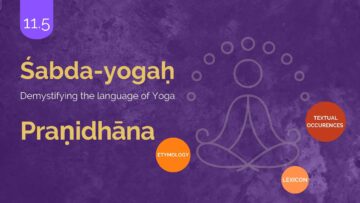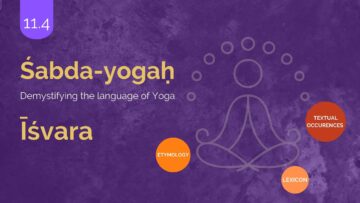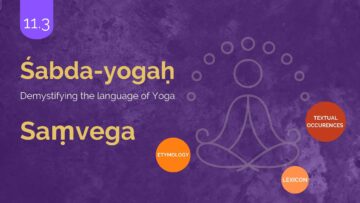Introduction
In this series, Yogic terminologies will be taken up and their –
- Etymological analysis,
- Lexical descriptions and
- Textual occurrences in Yogic literature and their commentaries, as available, will be presented. And finally observations will be made on the references.
Three texts – Yogasūtra, Haṭha-yoga-pradīpikā and Bhagavad-gītā are consulted for textual occurrences portion.
Śabda-yoga is intended to help students, teachers, and professionals of Yoga to develop a sound grammatical, contextual, and thereby an authentic and immersive understanding of Yoga terminologies.
List of Words
We will take up important Yogic terms from Sūtra s 1.17 – 20. The terms that will be analyzed in this Unit are –
10.5 Śraddhā
Etymology
श्रत् + धा +अङ् = श्रद्धा
śrat + dhā +aṅ = śraddhā
As evident from the derivation above
- Śrat is the prefix. This is not given any specific meaning in the traditional dictionaries.
- Dhā is the root. The meaning is धारणपोषणdhāraṇapoṣaṇa– to support and nourish.
Both the prefix and the root are used together in the formation of the word – śraddhā together – that is conventionally used to mean intense faith.
- Aṅ is the suffix. The suffix is added as per the grammatical rule षिद्भिदादिभ्योऽङ्ṣidbhidādibhyo’ṅ (aṣṭādhyāyī3.3.104). The suffix is just added to bring the feminine gender to the term.
As evident the etymology to the word śraddhā does not point to a derivative statement. The meaning – intense faith/desire/devotion – is more a conventionally adduced sense to the term.
Lexicon
There is just one reference to the word from the Amarakosha.
श्रद्धासम्प्रत्ययःस्पृहा 3.3.102
śraddhāsampratyayaḥspṛhā
This reference indicates that the word śraddhā is used to indicate – firm conviction (sampratyaya) and desire (spṛhā)
Textual Occurrences
Yogasūtra
There is just one reference to the word in Yogasūtra. It is as follows
श्रद्धावीर्यस्मृतिसमाधिप्रज्ञापूर्वकइतरेषाम्॥१.२०॥
śraddhāvīryasmṛtisamādhiprajñāpūrvakaitareṣām .. 1.20 ..
Śraddhā is presented as the chief among the upāyas/means to attain asaṃprajñātaSamādhi. Sage Vyāsa the primary commentator states –
श्रद्धाचेतसःसंप्रसादः –
śraddhācetasaḥsaṃprasādaḥ –
Śraddhā refers to the intense desire in the mind. VācaspatiMiśra the primary sub-commentator clarifies that such an intense desire – is about the subject/concept that has been taught by the authoritative texts (Āgama) and clarified by the Ācāryas.
(सचाऽऽगमानुमानाचार्योपदेशसमधिगततत्त्वविषयोभवति – sacā”gamānumānācāryopadeśasamādhigatatattvaviṣayobhavati).
The object, obviously is the Puruṣa or the pure consciousness.
Bhagavadgītā
There are nine references to the Śraddhā in this text. As the references are numerous the gist of the references is presented hereunder.
- Verse 4.39 states that – knowledge is attained by a person with Śraddhā. (श्रद्धावांल्लभतेज्ञानम्śraddhāvāṃllabhatejñānam).
- Verse 4.40 makes it clear that – a person who is not endowed with Śraddhā and is full of doubt gets destroyed.
- Verse 6.37 is in the form of a question of Arjuna. He asks to Śrīkṛṣṇa– a person is endowed with Śraddhā but is distracted from the path of Yoga which he was pursuing thus far – what happens to him?
- Verse 7.21 and 7.22 are the word of Śrīkṛṣṇa. The Lord states that whichever devotee wants to worship with Śraddhā (deep faith) whichever form – I grant them śraddhā in that divinity. And with that Śraddhā a person carries on with his worship and attains the desired results.
- In Verse 9. 32 – Lord Śrīkṛṣṇa clarifies that those who worship other divinities (other than Śrīkṛṣṇa) with Śraddhā – ultimately worship me only – but they do not follow the appropriate steps.
- Verse 17.1 is in the form of question of Arjuna again. He states – those who do not follow the prescribed rules of worship but are endowed with Śraddhā– under what category can their dedication be classified – Sattva, Rajas or Tamas?
- Verse 17.2 is where Śrīkṛṣṇa commences to respond to the question raised by Arjuna in the previous verse. Śrīkṛṣṇa states that śraddhā itself is of three types Sattvik, Rajasic and Tamasic.
- Verse 17.3 is a continutation of Śrīkṛṣṇa’s response. Here the lord clarifies that śraddhā of the person is dependent upon the pre-existing dispositions of the mind of the seeker in the form of saṃskāra The quotation in that regard from Ācārya-śaṅkarabhagavatpāda’s commentary is as follow – सत्त्वानुरूपाविशिष्टसंस्कारोपेतान्तःकरणानुरूपा – sattvānurūpāviśiṣṭasaṃskāropetāntaḥkaraṇānurūpā.
Haṭhayogapradīpikā
There is just one reference to the word śraddhā in this text.
सहजोलिरियंप्रोक्ताश्रद्धेयायोगिभिःसदा।
अयंशुभकरोयोगोभोगयुक्तोऽपिमुक्तिदः॥३.९४॥
sahajoliriyaṃproktāśraddheyāyogibhiḥsadā .
ayaṃśubhakaroyogobhogayukto’pimuktidaḥ .. 3.94 ..
This verse concludes the description of the practice of Sahajoli, one among the ten mudra-s elaborated in the third chapter of the text. The verse advises that Yogins should hold this practice with great devotion (Śraddhā).
Tabulation of Textual References 10.5
Observations
It is important to note that the word Śraddhā finds mention in all the three Yoga texts consulted. Yogasūtra and Bhagavadgītā give great importance to Śraddhā whereas there is just a passing mention to the term in Haṭhayogapradīpikā.
1) Yogasūtras place primary importance to Śraddhā which is intense desire – about the object (the pure consciousness) described by the authoritative texts and the teachers. It is Śraddhā that facilitates progress in other practices of Yoga.
2) Śraddhā in the Gītā has the following important implications –
- Śraddhā (deep faith) leads to knowledge.
- Opposite of Śraddhā is doubt that leads to doom.
- Even if there is inconsistency in practice of Yoga – if there is Śraddhā in the person – he will still be on track towards attainment of the spiritual goal
- Śraddhā is of three types Sāttvik, Rājasic and Tāmasic.
- Sāttvik, Rājasic and Tāmasic Śraddhā depends upon one’s own inherent predisposition caused by the Saṃskāras.
These are the significant insights that emerge from this discussion of Śabdayoga on the term Śraddhā.
Links for previous posts in this unit
Disclaimer: The opinions expressed in this article belong to the author. Indic Today is neither responsible nor liable for the accuracy, completeness, suitability, or validity of any information in the article.

